Sri Lankan parliamentary election, 2001
|
|
||||||||||||||||||||||||||||||||||
|---|---|---|---|---|---|---|---|---|---|---|---|---|---|---|---|---|---|---|---|---|---|---|---|---|---|---|---|---|---|---|---|---|---|---|
|
||||||||||||||||||||||||||||||||||
|
All 225 seats to the Parliament of Sri Lanka 113 seats were needed for a majority |
||||||||||||||||||||||||||||||||||
| Turnout | 76.03% | |||||||||||||||||||||||||||||||||
|
||||||||||||||||||||||||||||||||||

Winners of polling divisions. UNF in green and PA in blue.
|
||||||||||||||||||||||||||||||||||
|
||||||||||||||||||||||||||||||||||
Ratnasiri Wickremanayake
People's Alliance
Ranil Wickremesinghe
United National Front
Parliamentary elections were held in Sri Lanka on December 5, 2001, just a little over a year after the last elections in October 2000.
The People's Alliance (PA) government faced a blow when most of the SLMC MPs left the coalition. President Chandrika Kumaratunga tried to recruit the JVP to replace it, but this angered several PA MPs, thirteen of which defected to the opposition. A no-confidence motion was prepared; to forestall this, Kumaratunga called the election.
More than 1,300 incidents of election violence were reported during the campaign. [1]. Prime Minister Ratnasiri Wickremanayake was nearly killed by a suicide bomber. Overall, 60 people were killed in election-related violence, including 14 on polling day. [2]
Kumaratunga's People's Alliance lost the resulting general election, which saw the United National Front win the legislative power. The UNP's leader, Ranil Wickremasinghe, became the new prime minister.
Having a President and Prime Minister from different parties proved to be unstable, and Parliament was dissolved again in 2004, leading to yet another general election.
...
Wikipedia


